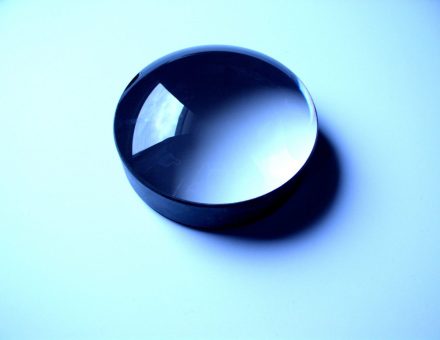Digital imaging lenses are often made of multiple lens elements to achieve the required specifications. How are those lens elements made in mass production? The answer to this question depends on the type of element chosen by the lens design engineer. Three types of lens elements are commonly used today. They are polished glass elements, molded plastic elements, and molded glass elements. Each type of element has its own unique process steps and capabilities. A good understanding of the manufacturing process for each type can help to ensure that the lens design can be successfully realized in practice.
- Polished glass: This type of element is the best known and most common. The elements used by Galileo in his refractive telescope were made by this method. Though the basic idea of how to make a polished glass element hasn’t changed for centuries lot of progress has been made in the speed and precision of the manufacturing process. The steps in making a polished glass element involves first making a blank from the chosen glass material type. Today there are hundreds of different types of glass materials available from several major optical glass manufacturers. Each glass type has different optical, mechanical, chemical, and thermal properties. It is the task of the lens designer to choose the appropriate glass material based on the end application requirement. Once the glass type is chosen there are two ways to make a blank. For small quantity needs one can CNC machine a rough oversized shape resembling the final element. For higher volume production the glass manufacturer can provide a molded blank having the approximate shape. In either case, the glass blank is then mounted on a grinding machine where a grinding wheel forms the two surfaces of the elements to the required radii. After grinding where the surface radii are approximately formed a final polishing step is used to make each surface smooth and shining. An optional optical coating is then applied to each surface using an optical coater. The final step is to center the element on a centering machine and a precise diameter is achieved by grinding down the excess material. This process has been perfected over many centuries. The capabilities of this process are amazing. Element sizes ranging from small endoscopic lenses to large telescope mirrors are made using this basic process. However, because of the grinding and polishing processes only flat or spherical shapes can be made. If a lens design calls for an aspherical element in either glass or plastic we would need to use the following processes.
- Molded plastic: Optical plastic materials offer very attractive properties for certain applications such as mobile imaging cameras. The predominant manufacturing process of plastic is injection molding. The basic process of injection molding is to melt the plastic resin so it can flow freely. This fluid is injected under high pressure to a precision mold cavity. The shape of the mold cavity determines the shape of the lens element. Once the mold cavity is filled it is cooled to allow the material to harden. Once the material is solid again it is removed from the mold. Depending on the size of the element the cycle time can be as short as a minute. Multi-cavity molds are often used to achieve high-volume production. These characteristics of injection molding allow for the economic production of lens elements with a high degree of precision. A major technical benefit of injection molding is that almost any shape can be molded as long as the mold cavity can be fabricated in the first place. This freedom allows lens designers to use aspherical or freeform profiles in the lens design opening up additional performance advantages such as compact size and high image quality. Today almost all mobile camera lenses are made by injection molding method. A major disadvantage of plastic materials is that their index of refraction depends on the environmental temperature. This sensitivity to temperature makes the plastic elements unsuitable for some applications where an extreme temperature environment is expected. There are design techniques one can apply to “de-sensitize” lens designs with plastic elements. Sunex has successfully commercialized many hybrid lenses using a combination of plastic and glass elements with such a design strategy.
- Molded glass: The glass molding process overcomes the limitation of the glass polishing process as outlined above (only flat or spherical surfaces can be polished). Glass material can be heated to a point where the material becomes soft. This soften point varies from glass to glass. The typical glass soften temperature is 500C to 600C. One starts with a glass preform made using machining or polishing process. The preform is then heated to the soften point and compressed between two cavity surfaces of a mold. This forces the glass preform to take on the shape of the mold cavity surfaces. Once the preform is sufficiently cooled, the molded element is removed from the glass mold. The key technical advantage is that the surface shape can be aspherical or freeform while the material can be glass instead of plastic. Glass materials have much better temperature and environmental stability making them suitable for a wide variety of applications where extreme temperature or harsh conditions may be encountered. The major disadvantage is that the molding process for glass can have a longer cycle time compared with that of injection molding because of the higher soften temperature required for glass. There are also limitations to the shape and materials that can be processed. Thus molded glass elements are only used in applications where this increased cost can be justified. If a design must use molded glass it is preferable to minimize the number of molded glass elements to lower the manufacturing risk and cost.
For a lens design to be successfully produced in mass production it is important to choose the best design strategy based on manufacturing process considerations. Should the design be all polished glass elements? Should it contain molded plastic or glass elements? If yes, how many and where? Are the material choices and shape manufacturable by their respective processes? Can the required tolerances be achieved? How to optimize the overall cost and yield? These questions require in-depth process knowledge not captured by today’s lens design software such as Optics Studio or Code V. Talk to our engineers about your application requirement. Let us help you to make your design more manufacturable.


